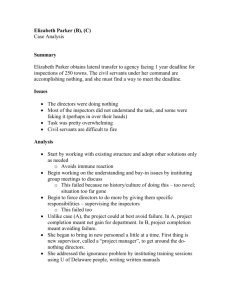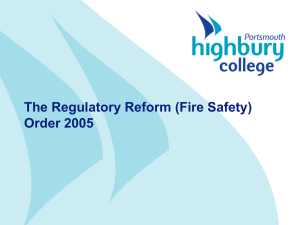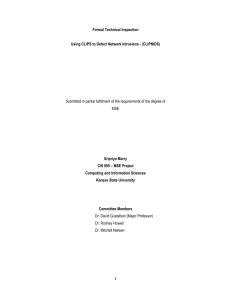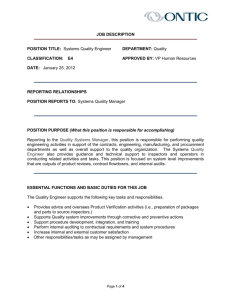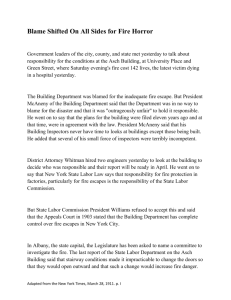Public Health Inspectors - Environment Health Officers
advertisement
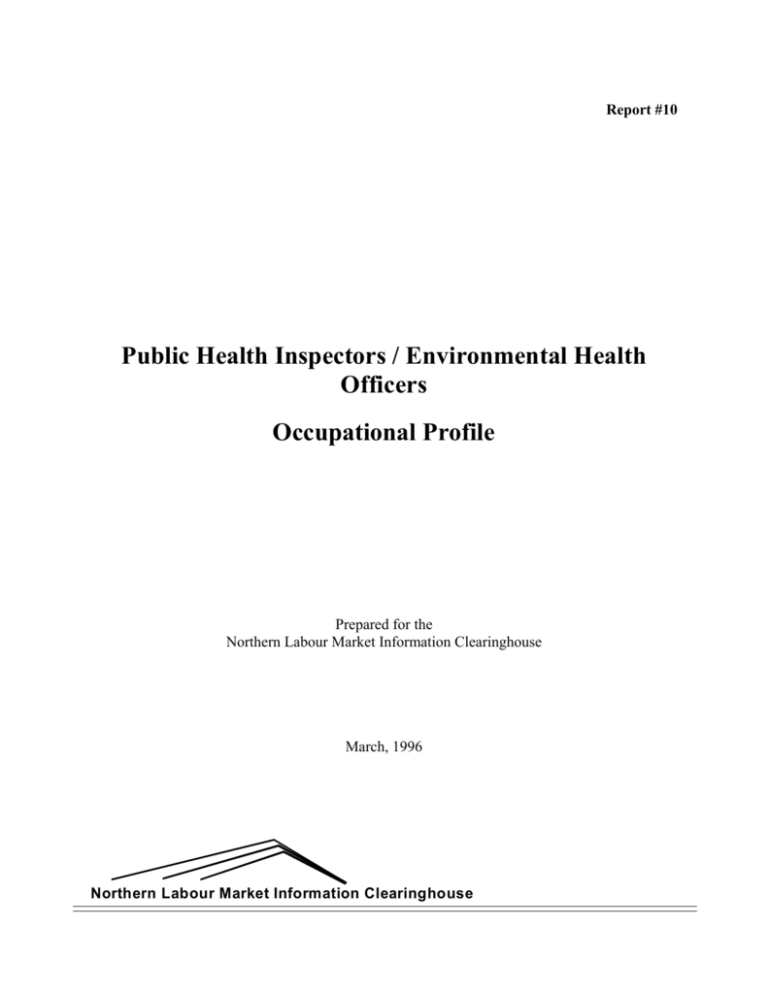
Report #10 Public Health Inspectors / Environmental Health Officers Occupational Profile Prepared for the Northern Labour Market Information Clearinghouse March, 1996 Northern Labour Market Information Clearinghouse Introduction This report arises from the Clearinghouse Advisory Committee’s interest in both the health sector and in the province’s changing regulatory structures and how these will affect the regulatory labour force in northern Alberta. In addition to a few printed sources, this reports relies heavily on a survey of public health inspectors from the seven northern Alberta health regions. Interviews were also conducted with representatives of the Canadian Institute of Public Health Inspectors and of local industries. While the this report focuses on PHIs as employed in the public health system the main training opportunities may involve related occupations in industry as well. Job Description Public health inspectors (PHIs), or environmental health officers as they are called in some jurisdictions, operate under the authority of the Public Health Act to minimize health hazards to individuals and communities. Their areas of responsibility include: water supplies, food processing and service establishments, waste disposal systems, hotels, housing, and swimming pools and other recreational facilities. They also deal with communicable disease control, insect and rodent control, indoor air quality, public health complaints and many other issues. The PHIs’ job involves inspection of facilities, education of operators, staff and the general public about sanitation and safety issues, and, occasionally, the use of legal sanctions to enforce the Public Health Act. Much of a PHI’s time is spent dealing with members of the community. Training There are currently two accredited training programs in Canada for public health inspectors. The British Columbia Institute of Technology in Burnaby offers a two-year diploma program and Ryerson Polytechnical University in Toronto offers a four-year Bachelor of Applied Science degree in public health inspection. BCIT produces 30 graduates per year and Ryerson sends out between 40 and 60 new inspectors per year. Graduates of these programs are eligible to take exams to become certified public health inspectors. Certification is governed by the Board of Certification, Canadian Institute of Public Health Inspectors, and is recognized throughout Canada. Anyone entering a PHI program after 1995 will have to hold an appropriate Bachelor’s degree prior to certification. This would be in addition to the BCIT program. Edmonton’s Concordia College offers a one-year post degree diploma program in environmental health and is seeking approval for its graduates to sit the certification exams. All of the northern Alberta health regions provide ongoing training to their PHIs in the form of inservice courses. These are usually ad hoc sessions conducted in Edmonton or Calgary. There does not appear to be any training available in the north. Two reasons for this were suggested. Public Health Inspectors/Environmental Health Officers Occupational Profile 1 First of all, there are too few inspectors in any one area to make training programs economically viable. Secondly, the larger number of PHIs who will travel to a major centre for training gives inspectors the opportunity to interact and “network” with their colleagues. Employment Demand There are approximately 130 certified PHIs in Alberta, some 31 of whom work for health authorities in the NADC area. Nationally 95 to 98% of PHIs work in the public health sector. Other related occupations may include occupational health and safety officers and industrial pollution control officers. There is also a market for independent consultants in the field. Currently, the number of graduates in Canada fairly closely matches the demand for new inspectors. In Alberta, most jobs posted are filled within about one month. Job prospects in the public health sector appear to be stable. All of the health regions surveyed expect to have at least as many staff one year from now as they have today. Two respondents expect slight increases. In the long term, respondents see a growing need for inspectors. Growing populations and cuts made in the past have increased most inspectors’ workloads. While the vast majority of public health inspectors work in the public health sector, there are some jobs available in private industry. Companies in such sectors as forestry and petroleum are creating more positions in areas such as environmental controls, though these positions may require more, or sometimes less, specific training than PHIs have. At Shell Canada’s Peace River Complex one person looks after occupational safety while another deals with environmental and pollution concerns. At Daishowa-Marubeni International (DMI) in Peace River environmental staff and safety staff tend to be hired from among the ranks of employees in other departments who display an interest in, and aptitude for, this sort of work. The company arranges training for these people when possible and would like to do so locally rather than having to send them to Edmonton or Calgary for this training. The work that is most directly related to a PHI’s training would be in the area of industrial hygiene. DMI usually contracts out this work, which suggests a potential market for PHIs who want to establish themselves as consultants in the field. Developments in the Field Changes in legislation could have significant effects on the demand for PHIs in the future. Alberta Health is undergoing a three-year Regulatory Reform Plan in which all health regulations have to be reviewed. Where practical, regulations are to be combined or amalgamated to streamline the regulatory structure. For example, if health regulations overlap with labour regulations the two might be combined under the authority of whichever department is in the best position to enforce them. While this could result in fewer PHIs being needed, other evelopments such as the possible regulation of private sewage disposal would increase the need. Following the general government trend toward deregulation of industry, public health Public Health Inspectors/Environmental Health Officers Occupational Profile 2 legislation seems likely to move away from specific regulations toward “codes of practise”. Rather than set out exact ways of operating as regulations do, the codes would set out desired results which could be achieved in whatever manner is appropriate. For example, rather than require restaurants to wash their dishes in a solution containing a set amount of chlorine, the codes of practise would require dishes to meet a certain standard of cleanliness, leaving it up to the restaurateur to decide how to achieve that standard. This allows for easier integration of new technologies that may produce the desired results in more efficient ways. This could increase the market for environmental health consultants. Implications for Training and Employment Pre-employment training is not a promising area for new programs in public health inspection. Such increase as there may be in demand for inspectors will exhaust the supply of newly qualified PHIs, especially if Concordia College receives accreditation for its program. The strongest opportunity for training in this field would appear to be in the area of short inservice courses that would serve the needs of both public health inspectors and industry personnel. Given the current regulatory review process, it may be worthwhile to revisit this subject in two years or so. Public Health Inspectors/Environmental Health Officers Occupational Profile 3 Sources Alberta Advanced Education and Career Development, “Occupational Profiles”, 1995. British Columbia Institute of Technology, “Environmental Health: Public Health Inspector Training Program”. Pamphlet, November, 1995. Richard Bonshke, “Public Health Inspectors: Different From the Others?” in Environmental Health Review, Summer, 1987. Robert Kieley, “Public Image of Environmental Health Varies” Peace River Record-Gazette, January 21, 1996. Contacts Mike Duncan, Peace Health Region. 624-3611. Rob Elliot, Canadian Institute of Public Health Inspectors (and David Thompson Health Region). 341-2156. Dee Hampel, Northwest Health Services Region. 926-7000. Robert Kieley, Peace Health Region. 624-3611. Cherri Kilgore, Shell Canada Ltd. Peace River Complex. 624-6800. Alex Mackenzie, Northern Lights Regional Health Authority. 791-6068. Jim Meagher, Mistahia Health Region. 532-4441. Ron Pillidge, Aspen Regional Health Authority. 939-3699. Stan Sherman, Lakeland Regional Health Authority. 467-5571. Lydia Stephaniw, Stony Plain Health Authority. 962-4072. Tom Tarpey, Environmental Manager, Daishowa Marubeni International Peace River. 6247070. Daria Wallsten, Keeweetinok Lakes Regional Health Authority. 849-3947. Public Health Inspectors/Environmental Health Officers Occupational Profile 4

